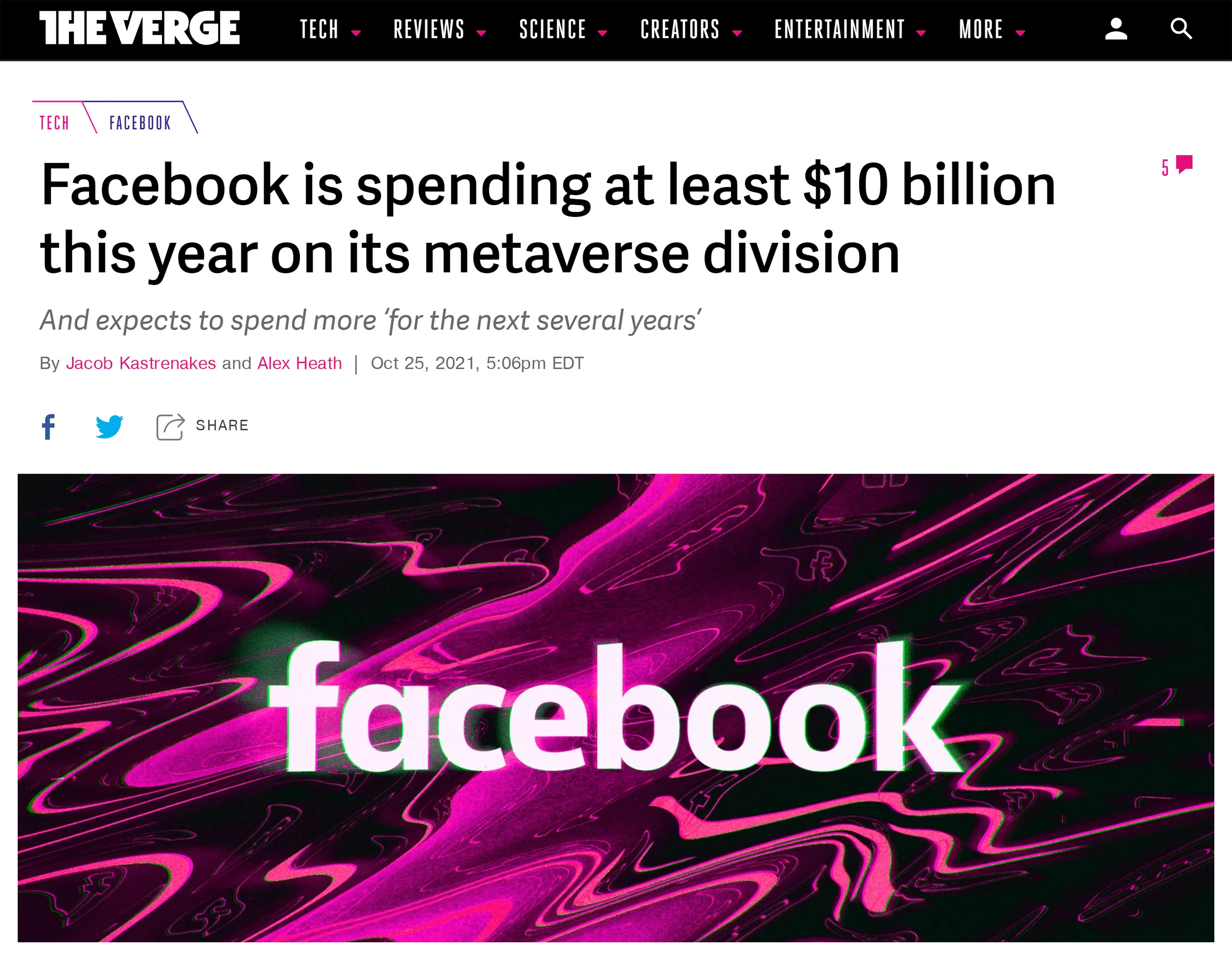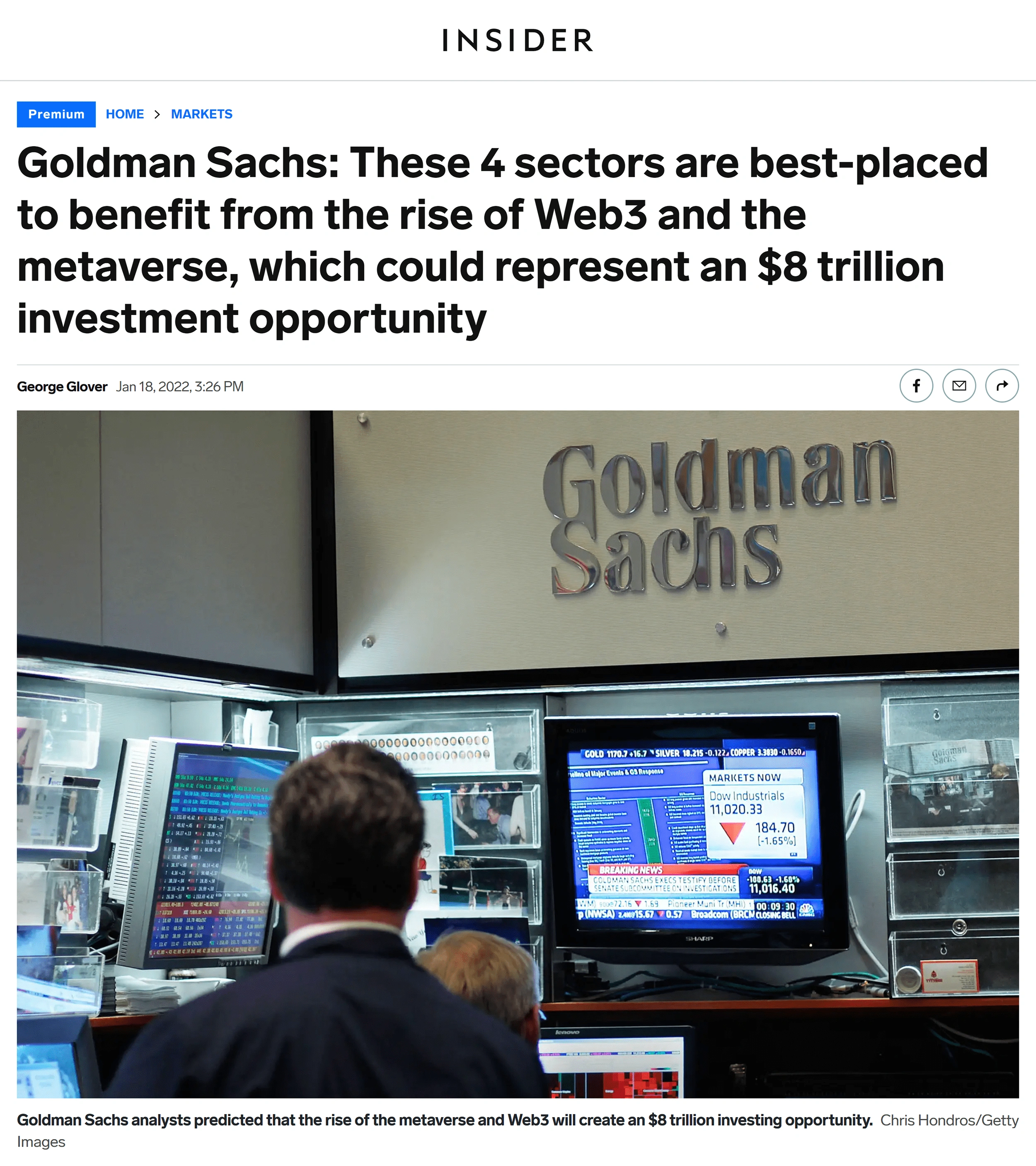In this chapter, we’ll define the metaverse, explore the players betting big money on its future, and discuss the origins of this emerging technology.
The Metaverse Defined
The metaverse is a large-scale 3D virtual environment that allows users to dynamically interact with each other.
While true in a literal sense - and appropriate to the metaverse in its current state - futurists have a much more grandiose vision for what the concept could become in the future.
And few have stated that vision more clearly than Tony Parisi, CEO of game development company Unity.
In what’s become a highly circulated Medium article, Tony’s “Seven Rules of the Metaverse” defines this futuristic technology as follows:
“The Metaverse will be an “enhanced and upgraded” version of our current-day internet that will “consistently deliver 3D content, spatially organized information and experiences and real-time synchronous communication.”
In plain English, the metaverse refers to the concept of a fully immersive, fully digital world.
It’s the culmination of today’s most promising, futuristic technologies: Virtual Reality, 3D visuals, digital economies (powered by NFTs, crypto and blockchain) and much, much more.
As is the case with most any emerging technology (let alone a hot topic getting lots of press attention), there are strong opinions both in favor of - and against - the concept.
But one thing is for sure: With many of today’s largest technology companies pouring hundreds of millions of dollars into building their own metaverse, this is a trend many people are taking seriously.
The Statistics
Admittedly, the metaverse (as most proponents envision it) doesn’t exist yet.
Because of that, the adoption of this emerging technology can’t be measured via standard metrics (monthly users, annual revenue, etc.).

However, similar to how companies invested billions into building the Internet during the late 1990s and early 2000s, companies are now pouring serious money into building the infrastructure of what (they hope) will become the metaverse.
As an example, Meta Platforms Inc. (aka Facebook) announced they’ll be investing $10 billion into building their own metaverse over the coming decade.
Shortly after, a tech competitor announced a $67 billion acquisition of AAA gaming studio Activision. Given modern video games are the closest thing we have to a “metaverse,” many interpreted the acquisition as Microsoft’s announcement they too will be joining the fray.
And it’s just not big tech companies who want to get in on the action.
As of January 2022, investing heavyweights Fidelity and ProShares both announced they’ll be launching a metaverse ETF (which allows investors to invest into a basket of metaverse-focused companies).

Which begs the question: What do these tech companies see that skeptics don’t?
Fortunately, one doesn’t have to look far to find the answers.
Precursors to the Metaverse
While the “true” metaverse will be a fully immersive digital experience (in which one wears a VR headset and fully disconnects from their local surroundings), one could argue nascent versions of the metaverse already exist.
In April of 2020, more than 12 million people attended Travis Scott’s virtual Fortnite concert (Fortnite was the most popular video game in the world in 2021, and one many believe is a precursor to the future metaverse).
In another video game-oriented example, more than 11 million people participate in the virtual world video game Animal Crossing (with one user claiming to have spent 2,300 hours playing the game).
Admittedly, playing a video game and living in a digital world are two very different things.
However, that didn’t stop Goldman Sachs from predicting the metaverse could become an $8 Trillion dollar industry.
With that said, despite “metaverse” becoming one of 2021’s hottest buzzwords, in reality, the concept has been around for decades.
A Brief History of the Metaverse
The term “metaverse” was first coined by science fiction author Neal Stephenson in his 1992 work Snow Crash.
More recently, Ernest Cline’s best-selling Ready Player One demonstrated what an actual metaverse-based society might look like.
With that said, given the metaverse refers to the concept of a virtual world, some argue the metaverse is already here (and has been here for decades).
As an example, players have been building virtual worlds in the popular Sims video game since it first launched in 2000. And with some pretty fancy graphics, it’s hard to deny the game’s current (and fourth) version may be one of the closest examples we have as to what a metaverse might look like.
In fact, the concept of building virtual worlds - known as World Building - is nothing new to gamers. Case in point: World of Warcraft.
With almost five million players in 2020 alone, WoW gamers have been using avatars to build virtual worlds for years.

However, there’s a massive difference between today’s video games and the metaverse envisioned by both authors and futurists alike:
First, video games are played on 2D screens (from smartphones to PC monitors and even TVs). Second and most important, people interact with video games while still mentally and psychologically present in the real world.
On the flip side, futurists envision the “true” metaverse as a 3D virtual reality where you are so mentally immersed you disconnect from your body’s physical surroundings.
And based on some pretty funny YouTube videos, that level of immersion is not just a futuristic goal, but one that’s already here today.







